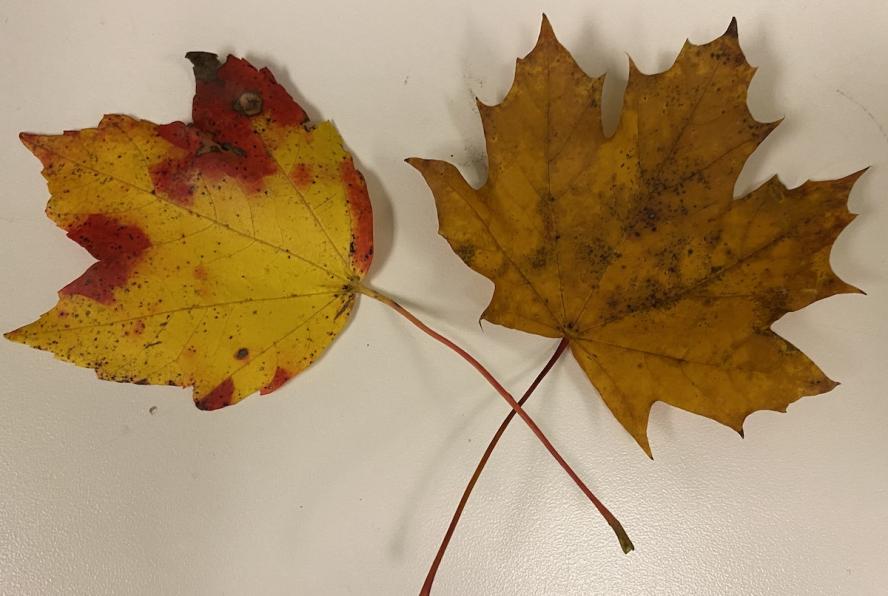-
About
- Leadership & Faculty
- News & Events
-
Academics
- Graduate
- Advanced Clinical Training
- Continuing Education
- Academic Departments
- Academic Offices
- Simulation Experiences
-
Student Life
- Offices
-
Research
-
Hospitals & Clinics
- Emergency Care
- Hospital Services
-
Community Outreach
- Volunteer
The Truth About Red Maple Leaf Toxicity
Ask the expert

As trees shed their leaves this autumn, a Cummings School expert shares the dangers of horses consuming red maple leaves.
Q: Can horses die from eating red maple leaves?
A: The simple answer is yes. They do, and we see multiple cases at Cummings School’s Hospital for Large Animals every year. Most people can identify a maple tree, but when people hear red maple, they often think of the Japanese maple. The scientific name for red maple is Acer rubrum, but people also call them either swamp, water, or soft maples. They live almost everywhere and tolerate anything from very dry to very wet conditions. Because it is a pretty tree, many people use it for shade, even in pastures, without knowing they can be highly toxic to horses. Red maples are green in the summer, but their veins and stems are red, and their leaves are jagged, rather than scalloped like the sugar maple. And in autumn, the red maple turns vivid shades of red, gold, and orange.
Fresh red maple leaves are not toxic to horses – but wilted or dried leaves and the bark are extremely toxic. Eating about 1.5 pounds can make a horse very sick and ingesting 3 lbs. can kill a horse. An average horse eats 15–20 lbs. of hay daily, so eating a small amount of red maple is quite hazardous.
We see most cases of red maple toxicity after late summer and autumn storms take down branches. Once the leaves have fallen, they stay toxic for about four weeks. Luckily, horses tend not to want to eat the dry leaves that fall unless they are not receiving enough hay or other forage. Horses that cannot eat hay due to old age, bad teeth, or complications such as poor gastric emptying, are at risk because they crave forage and will even eat wood to get it. Young horses tend to be more adventurous in what they eat, so they are at higher risk. Camelids – llamas or alpacas – are also susceptible to red maple toxicity, but ruminants are not.
How horses are affected
Red maple contains multiple toxins that cause two different and severe problems with the horse’s red blood cells. Gallic and tannic acid (the same type of toxins that we see in oak) cause destruction of red blood cells, called hemolysis. Another toxin, called pyrogallol, causes methemoglobinemia, which prevents red cells from being able to carry oxygen.
Red blood cells help carry oxygen around the body, so the combination of loss of red cells due to hemolytic anemia, and dysfunctional red cells due to methemoglobinemia cause the constellation of signs that we see in red maple toxicity, including weakness, depression, colic, and laminitis. Other signs can include pale gums, rapid heart rate, and flared nostrils. This indicates an insufficient amount of oxygen in the body.
You may notice red-brown urine in the shavings – that is the remnants of red cells that have been destroyed and are being filtered out by the kidneys. If horses have a significant component of methemoglobinemia, their mucus membranes may look muddy brown.
There is no specific test for red maple toxicity. It is a clinical diagnosis based on exposure to red maple leaves along with severe hemolytic anemia, especially if we see Heinz bodies in the red cells due to oxidative damage.
Treatment
Treatment for red maple toxicity is largely symptomatic. Unfortunately, owners usually notice signs a day or two after the horse eats the leaves, and it isn’t possible to prevent absorption of toxin in this case. If you realize that your horse has recently eaten red maple leaves your veterinarian may give activated charcoal or mineral oil to try to prevent absorption of toxins. We usually give intravenous fluids to prevent dehydration—horses who don’t feel well often don’t want to drink—and to prevent kidney damage from all the red cell remnants that the kidneys must filter out.
If horses become colicky, we may need to treat them with flunixin (Banamine), in which case it is even more important to make sure that they are well-hydrated. There are no data to suggest that treatment with corticosteroids, Vitamin C, or methylene blue helps in horses. In severe cases, a blood transfusion may be necessary, but as there is no such thing as a perfect match in horses, we reserve this for when it is absolutely necessary, as we can do more harm than good in a horse that is not in need.
Prevention
To help prevent red maple toxicity, follow these steps.
- Remove all red maples and red maple leaves that horses can encounter. Bored horses eat bark, which is also toxic.
- Be vigilant in inspecting pastures after a storm. Even if your pastures don’t have red maples, it is possible for branches or leaves to blow on to your land.
- Make sure that your horses have plenty of good, tasty hay or other safe forage. This will usually keep them from wanting to eat leaves or bark.
- Inspect your hay for any leaves—if you see any red maple leaves, feed the hay to ruminants like cattle, sheep, and goats, but not alpacas or llamas.
Dr. Melissa Mazan, V93, is a board-certified internist at the Hospital for Large Animals at Cummings School of Veterinary Medicine. She completed an internship in equine surgery and sports medicine and a residency in large animal internal medicine at Cummings School. She directs the Equine Bronchoalveolar Lavage Cytology Laboratory, and while her research is in equine asthma, she commonly treats colic, enteritis, gastric ulcers, pneumonia, neurologic disease, fevers of unknown origin, and more.